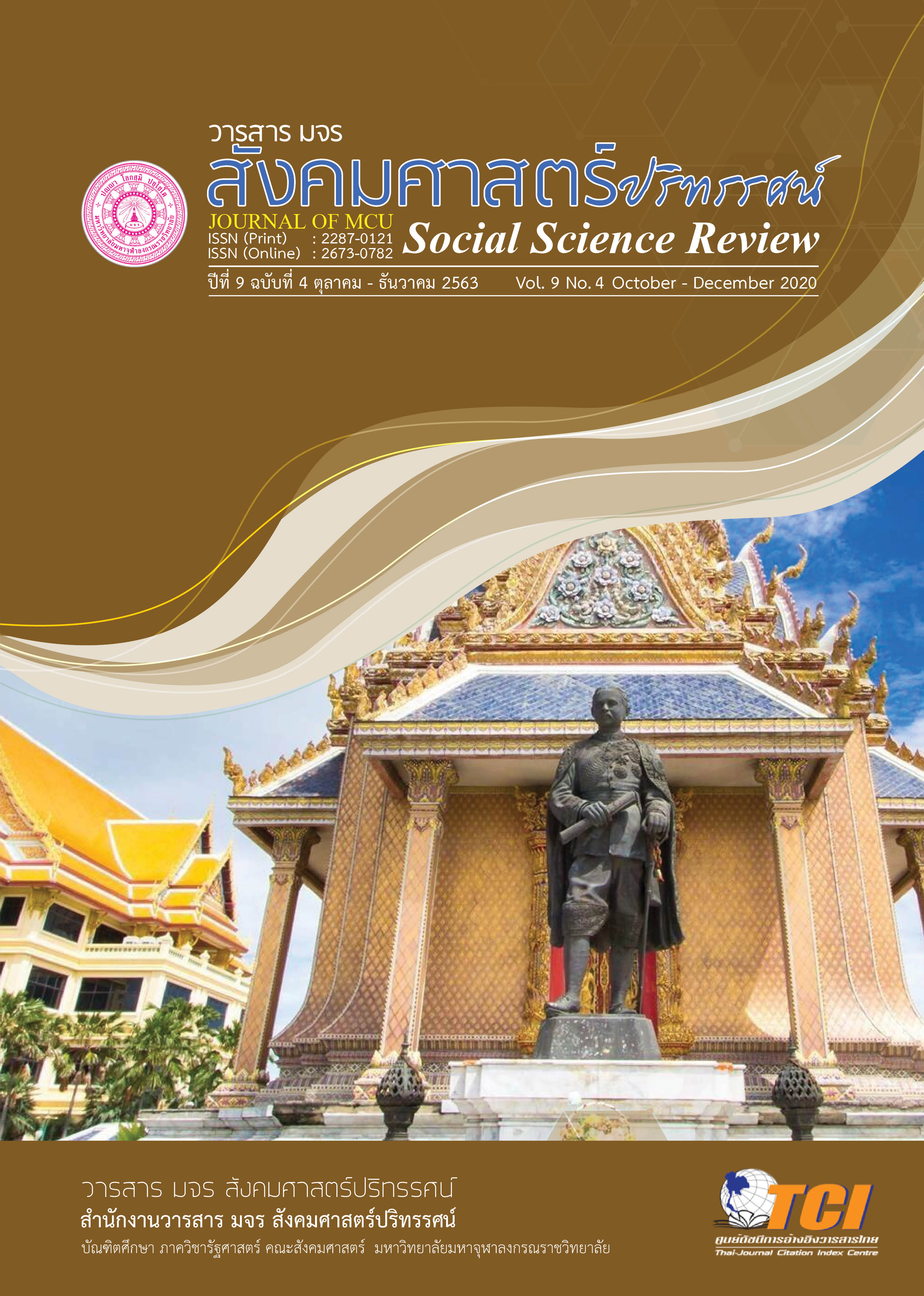ประสิทธิผลการนำนโยบายการแก้ปัญหาจราจรไปปฏิบัติของกองบังคับการตำรวจจราจร
คำสำคัญ:
ประสิทธิผล, นโยบาย, การแก้ปัญหาจราจรบทคัดย่อ
บทความวิจัยนี้มีวัตถุประสงค์เพื่อศึกษาระดับการนำนโยบายไปปฏิบัติ ปัจจัยที่มีผลต่อประสิทธิผลการนำนโยบายการแก้ปัญหา และนำเสนอการพัฒนาการเพิ่มประสิทธิผลการนำนโยบายการแก้ปัญหาจราจรไปปฏิบัติของกองบังคับการตำรวจจราจรโดยการบูรณาการหลักพุทธธรรม เป็นการวิจัยแบบผสานวิธี โดยการสำรวจข้อมูลจากกลุ่มตัวอย่าง 350 คน วิเคราะห์ข้อมูลโดยใช้ค่าความถี่ ค่าร้อยละ ค่าเฉลี่ย ส่วนเบี่ยงเบนมาตรฐาน การวิเคราะห์สหสัมพันธ์และการวิเคราะห์การวิเคราะห์การถดถอยพหุคูณ และการวิจัยเชิงคุณภาพเป็นการศึกษาภาคสนามด้วยวิธีการสัมภาษณ์เชิงลึก จากผู้ให้ข้อมูลสำคัญ 17 รูปหรือคน และการสนทนากลุ่มเฉพาะเพื่อยืนยันโมเดลหลังจากการสังเคราะห์ข้อมูล ผลการวิจัยพบว่า 1. ประสิทธิผลการนำนโยบายการแก้ปัญหาจราจรไปปฏิบัติ โดยภาพรวม อยู่ในระดับมาก (= 3.99, S.D.= 0.586) 2. การปฏิบัติตามหลักฆราวาสธรรม 4 มีอิทธิพลต่อมีผลต่อประสิทธิผลการนำนโยบายการแก้ปัญหาจราจรไปปฏิบัติของกองบังคับการตำรวจจราจร อย่างมีนัยสำคัญทางสถิติที่ระดับ 0.01 โดยเรียงลำดับความสำคัญดังนี้คือ ความอดทน ความจริงใจ การเสียสละ และการฝึกฝน โดยมีค่าสัมประสิทธิ์การตัดสินใจที่ปรับแล้ว (Adj. R2) เท่ากับ 0.353 3. การบูรณาการหลักพุทธธรรมได้แก่ หลักฆราวาสธรรม 4 ประกอบด้วย 3.1 ความอดทน อดกลั้น ไม่ย่อท้อต่ออุปสรรค 3.2 มีความจริงใจต่อตนเองและผู้อื่น 3.3 การเสียสละ มีน้ำใจเอื้อเฟื้อเผื่อแผ่ต่อบุคคลอื่นและมีความซื่อสัตย์ 3.4 การฝึกฝนตนเอง
เอกสารอ้างอิง
ธัชพนธ์ ยอดทองและคณะ. (2562). ความสัมพันธ์ระหว่างองค์ประกอบของการบริหารจัดการจราจรกรุงเทพมหานคร. วารสารบริหารธุรกิจอุตสาหกรรม, 1(1), 74-82.
ธีร์ เกสทอง. (2561). รูปแบบการป้องกันการละเมิดกฎหมายจราจรของกองบัญชาการตำรวจนครบาล. วารสารวิจัยและพัฒนามหาวิทยาลัยราชภัฏสวนสุนันทา, 10(2), 13-28.
มหาจุฬาลงกรณราชวิทยาลัย. (2539). พระไตรปิฎกฉบับภาษาไทย ฉบับมหาจุฬาลงกรณราชวิทยาลัย. กรุงเทพฯ: โรงพิมพ์มหาจุฬาลงกรณราชวิทยาลัย.
ยุทธ ไกยวรรณ์. (2556). การวิเคราะห์สถิติหลายตัวแปรสำหรับงานวิจัย. กรุงเทพฯ: โรงพิมพ์จุฬาลงกรณ์มหาวิทยาลัย.
วรกานต์ สาระปัญญา. (2558). การจัดการจราจรในย่านศูนย์การค้า ย่านชุมชน และจุดบริการขนส่งสาธารณะ: กรณีศึกษาในเขตเทศบาลนครรังสิต (รายงานการวิจัย). กรุงเทพฯ: ศูนย์สารสนเทศการวิจัย สำนักงานการวิจัยแห่งชาติ (วช.).
วรพล วัฒนจึงโรจน์และคณะ. (2557). การศึกษาความสัมพันธ์ของตัวแปรกระแสจราจรบนถนนในเขตเมือง. วารสารวิชาการ วิศวกรรมศาสตร์ ม.อบ., 7(1), 37-45.
ศูนย์วิจัยกสิกรไทย. (2559). วิกฤตจราจรติดขัด: ผลกระทบต่อเศรษฐกิจ & วิถีชีวิตคนกรุงเทพฯ. CURRENT ISSUE, 22(2771), 1-6.
สุภางค์ จันทวานิช. (2549). การวิเคราะห์ข้อมูลในการวิจัยเชิงคุณภาพ (พิมพ์ครั้งที่ 7). กรุงเทพฯ: สำนักพิมพ์จุฬาลงกรณ์มหาวิทยาลัย.
________. (2553). การวิเคราะห์ข้อมูลเชิงคุณภาพ. กรุงเทพฯ: สำนักพิมพ์จุฬาลงกรณ์ มหาวิทยาลัย.
อธิราช มณีภาคและคณะ. (2558). ประสิทธิผลการบริหารจัดการการลดอุบัติเหตุทางถนนในกรุงเทพมหานคร. วารสารธรรมศาสตร์, 34(1), 209-219.
ดาวน์โหลด
เผยแพร่แล้ว
รูปแบบการอ้างอิง
ฉบับ
ประเภทบทความ
สัญญาอนุญาต
ลิขสิทธิ์ (c) 2020 วารสาร มจร สังคมศาสตร์ปริทรรศน์

อนุญาตภายใต้เงื่อนไข Creative Commons Attribution-NonCommercial-NoDerivatives 4.0 International License.
เพื่อให้เป็นไปตามกฎหมายลิขสิทธิ์ ผู้นิพนธ์ทุกท่านต้องลงลายมือชื่อในแบบฟอร์มใบมอบลิขสิทธิ์บทความให้แก่วารสารฯ พร้อมกับบทความต้นฉบับที่ได้แก้ไขครั้งสุดท้าย นอกจากนี้ ผู้นิพนธ์ทุกท่านต้องยืนยันว่าบทความต้นฉบับที่ส่งมาตีพิมพ์นั้น ได้ส่งมาตีพิมพ์เฉพาะในวารสาร มจร สังคมศาสตร์ปริทรรศน์ เพียงแห่งเดียวเท่านั้น หากมีการใช้ภาพหรือตารางหรือเนื้อหาอื่นๆ ของผู้นิพนธ์อื่นที่ปรากฏในสิ่งตีพิมพ์อื่นมาแล้ว ผู้นิพนธ์ต้องขออนุญาตเจ้าของลิขสิทธิ์ก่อน พร้อมทั้งแสดงหนังสือที่ได้รับการยินยอมต่อบรรณาธิการ ก่อนที่บทความจะได้รับการตีพิมพ์ หากไม่เป็นไปตามข้อกำหนดเบื้องต้น ทางวารสารจะถอดบทความของท่านออกโดยไม่มีข้อยกเว้นใดๆ ทั้งสิ้น





